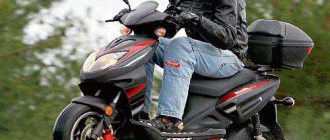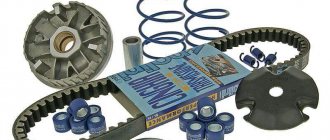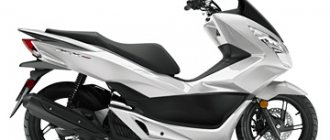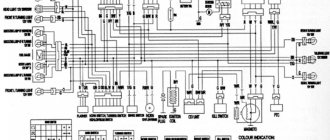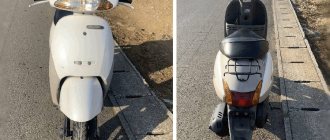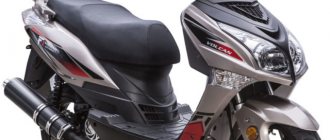Most bikers associate the word “ maxiscooter ” with a kind of imposing, calm and even boring sofa on wheels, but the Yamaha T Max is a completely different matter. Yes, this is indeed a full-fledged maxi-scooter, but Japanese engineers managed to cross a snake with a hedgehog, and successfully, and the fruit of this strange love was the Yamaha T-Max 500. Taking a comfortable scooter, the samurai equipped it with an angry and sharp engine, and fairly stiff sports suspensions and sportsbike brakes, presenting the public with the most controversial model in many years. But the experiment turned out to be successful, and the Yamaha T Max 500, having existed for quite a long time and having gone through several restylings, was eventually replaced by the T-Max 530. The newcomer as a whole is very similar to its ancestor, it has simply become even more modern, more technologically advanced and more convenient. And the T Max has never had any problems with reliability, judging by the reviews of the owners of this unit.
It is difficult to argue with the fact that for urban conditions a modern maxi-scooter is, in a number of ways , more convenient than a motorcycle. Either on a sportbike or on a cruiser, you most likely will not be able to arrive at your favorite office in a clean condition, especially in not the most pleasant weather. But the Yamaha T Max 500, like any other full-fledged maxi scooter, is warm and comfortable. It protects the pilot well from water, dirt, and wind, so if you really want to, you can ride even with a tie. However, some motorcyclists look down on maxiscooters, accusing them of being boring. We won’t argue with them, but simply offer them a ride on a Yamaha T Max. This maxi-scooter is capable of matching both the dynamics and maneuverability of most motorcycles of a similar cubic capacity, and at the same time the pilot on it can enjoy the ride rather than struggle with an uncomfortable landing and headwind. Well, who's boring here now?
The Yamaha T Max 500 is also good
for long trips . The compartment under the seat can accommodate substantial luggage, and if desired, no one bothers to add additional panniers . The power reserve of the sports maxi scooter is quite decent, and it has, perhaps, only one significant drawback in long-range travel - the small radius of the wheels, which can cause inconvenience on roads with poor quality asphalt. But subjectively, the Yamaha T-Max weighs quite a bit, despite what is written on its title. Some Suzuki Burgman or Honda Silver Wing feels much heavier. In the T-Max, the center of mass is shifted down, which allows it to maneuver even at near-zero speeds.
It’s worth saying a few words about the design. He was quite good at the very first generation of Yamaha T Max, and since then he has only gotten better. For example, the 4th generation, also known as the T-Max 530, looks moderately futuristic, but at the same time familiar features are still visible in it. And the whole appearance of the T-Max seems to hint that this is not just another two-wheeled bumpkin a la “sofa on wheels”, this is truly a sports bike that can surprise even an experienced motorcyclist.
10 years later
The Yamaha T Max has been produced for over 10 years, and for ten years it has been the best-selling vehicle in its class. Not surprising, because today it is impossible to find any worthy analogue for approximately the same cost.
At first, an opinion may arise (every second Yamaha T Max 500 forum talks about this) that the presented maxiscooter is not anything special. The maximum possible power of a steel horse is 46 horses, and the torque is 52 newton meters.
At first, on earlier motorcycle models these figures were lower, but the difference was barely noticeable. Overall, the updated motorcycle, produced over the past few years, is faster, more fun and better than the first model versions. This is especially true in the lower rev ranges. Thanks to the efforts of the developers, the updated, improved maxi-scooter now has a belt drive and an injector. By the way, previously the drive was chain.
City
The variator of the two-wheeled model operates smoothly and very softly, so that the loss of power is barely noticeable. This makes the maxiscooter a dynamic and high-quality device. The upper speed limit is 170 kilometers. Due to such parameters, the nimble Yamaha feels good in the city - there is enough dynamics and visibility in busy traffic conditions.
Like all its classmates, this two-wheeled high-speed friend has everything you need to rightfully become the best transport for moving around urban conditions. These are chic, well-designed seats, with the same high-quality protection from water, wind and dirt. These points make the Yamaha T-Max a good choice for the purpose. This is noted by fans visiting the Yamaha T Max Club.
You can ride this motorcycle to work even in a formal suit, and the person will arrive at the place of work in a clean suit.
Yamaha t max 500
Yamaha Tmax 500A: 499 cm3, 44 l. s., 160 km/h, $ 11800
Externally, it looks like a “normal” scooter enlarged by a third. Structurally and on the move, it’s an even more “normal” motorcycle. Only with a CVT and a very modest engine relative to its dimensions. All together - a more than convenient and practical vehicle. Moreover, it is “equidistant” from motorcycles, scooters, and cars.
RECONSTRUCTION
Just rumors about the appearance of this hybrid of a motorcycle and a scooter caused quite a stir. And a year later, in the fall of 2000, in Japan and Europe there was one more cult device - the course of current events was not affected even by the almost simultaneous appearance of a 600 cc “self-propelled sofa” from Honda, and a year later - from Suzuki. The device instantly became a sales leader among “maxi” models. And first of all, thanks to the combination of scooter comfort and motorcycle handling. Fortunately, for the latter “no cartridges were spared”: the motor is in the frame (the main gear is a chain in a sealed pendulum spar, simulating the body of a variator), the fork is “full-size”, and the wheels at that time were not quite scooter-sized, 14-inch.
Nevertheless, in the fall of 2003, the device was redesigned, and a year later, ABS appeared on it. It was just such a device (and this is the only one there could be: a version without this system is not delivered to us) that was put to the test. “Coated” optics, a modified saddle, and most importantly, a new “tidy” of a fashionable configuration - “two wells and an LCD display between them,” however, these “wells” are not too deep. The potential client is not too fond of the Alfa 156 - their cars, as a rule, are German brands. Although these measures did not make the scooter more striking, they pleasantly modernized the successful design of the work of the Dutch Yamaha studio - the same one where, several years earlier, another revolution in the motorcycle hierarchy was accomplished - the first generation of TDM. It's external. Inside, there are more serious differences: the rear wheel is an inch larger, there are two front brake discs, and the power unit has been completely rebuilt. The variator was newly developed, the cylinder head, pistons, carburetors gave way to injection... In general, Fedot, but not the same. What exactly it is, we will find out!
So, the backpack in the “toilet” (it remains the same, so I’ll just note: thanks to the rectangular shape and “crooked” bottom, you can put all sorts of things in there, then throw in a raincoat, and there will still be room for a bag with a laptop), documents and cigarettes in the “ glove compartment" - let's go.
Crawling out onto the highway, I have time to appreciate the stylishness and information content of the new “tidy” - truly, impeccable! But these are all minor things compared to the ease of seating: in terms of space for the driver, the Tmax is one of the leaders (only the Malaguti Spydermax is more spacious behind the wheel!), but, most importantly, the triangle “handles-saddle-footrests” is simply perfectly aligned here. But for those who are used to riding sportbikes, it will be a little difficult: the central tunnel, which sharply widens at the rear due to the wide engine, will not allow you to tuck your legs. But are we on a scooter or where?
WHERE IS HIS BUTTON?
On a scooter, exactly on it. And judging by the engine, it’s not very “supermaxi”. Yamaha promised to increase power by as much as 10%, but... Where are they, the declared 44 hp? With.? Moreover, the question is not rhetorical: I really still don’t understand where this increase was “lost.” The variator is configured, albeit not in a combative way, but without “smearing” when starting off, as on the “self-propelled sofas” and Tmax of the previous version. “Longer” final drive? Not without it. Having installed an enlarged wheel, the sprockets were clearly left the same as on the previous version. But the “extension” is quite insignificant. It’s certainly a sin to blame the lack of a particular specimen: my Italian colleagues (and in more than one magazine) also noted a drop in dynamics compared to the carburetor version. So why? Great is this mystery...
On the other hand, let’s not lie, because this device has both speakers and ears! Few people will “drain” the 400-meter Tmax, and medium-sized devices cannot be overclocked to such indicators even with the help of serious tuning. And with the “maximum speed” everything was completely fine: I had nowhere to fully squeeze out the indicators, but the speedometer needle reached about o, and even began to creep further. And if such speeds are not very necessary (and the vibrations at such speeds are too high), then I think no one will argue with me about the importance of rapid acceleration of 110-150 km/h.
...As well as about the reverse process! The brakes here are beyond criticism. Not the toughest (but is precision feedback needed here?), they made it possible to start braking with a huge margin. But it was not possible to test the ABS in practice; I later checked its presence, but only its presence. The fact is that the moment of its operation is very late, thanks to which the capabilities of the brakes are realized to the maximum extent, while the system operates exclusively for its intended purpose - to protect a not very skillful or very tired driver from the wheel stalling. And with such discs, and on a wet track, it’s easy to push the brakes to the point of failure. Just don’t, fellow sport bikers, throw dirty socks at me: on a Maxi, ABS is more than desirable, because they ride it not only on a sunny weekend, but also in the autumn slush, and often even after a 12-hour working day .
What about the rest of the chassis components? Yes, great! Not fantastic, but a fairly rigid frame, a full-size fork and a design with the engine in the frame rather than on the wheel (which means modest unsprung masses) provide excellent handling and a good smooth ride. The harsh reaction of the front fork to small irregularities spoils the impression a little, but it’s harsh, nothing more. In general and in particular, the chassis here is in order, moreover, its potential greatly exceeds the capabilities of the engine. So rumors about the future “charged” version of Tmax were not born out of nowhere.
...As a rule, during the tests of the first one and a half hundred keme, my “on-board computer” works in the “digitization” mode: what are the nuances at what speeds, where does it rattle, what kind of backlashes, etc. In general, a subjective reading of objective parameters. Then the actual driving begins. So here, I finished the second hundred, just from the bottom of my heart, “going all out” on the track. Day, Moscow Ring Road, heavy traffic, but no congestion.
In a word, I opened the handle between the rows so as to exceed the flow rate and not disturb anyone. Although “opened the handle” is a strong word. The maximum speed still did not exceed 140 km/h, but mostly lay within the range of 90-120 km/h. And then I caught myself thinking that on a good “mid-sized bike” (say, Runner 200), my average speed would be higher. Yes, the “face” is narrower than that of most “maxis”, yes, in some “holes” you can “throw your slippers on the floor” to speeds inaccessible to the mentioned “Big Runner”, yes, the distance can be kept less thanks to powerful brakes - but the fact remains a fact. But I would have been tired on a “mid-sized bike”, and thoroughly, after a hundred kilometers, here, thanks to the stability and smoothness of the ride that was not at all like a scooter and excellent wind protection, I did not look like a living corpse after seven hours in the saddle.
BUSINESS CLASS
Frankly, organizing this test was more difficult for me than any other in my entire journalistic career. Last year I repeatedly tried to snag Tmax for testing - it was useless. This model is literally imported one by one, and those devices that were imported were prepaid by customers on the way to Moscow. The situation repeated itself a year later.
Artificial deficiency? Or marketers' uncertainty about the car's prospects? Apparently, the second, judging by the method of promoting the scooter to the market: here it is presented as a motorcycle! It is clear that in this capacity the device cannot compete with the “six hundred”, and an “automatic” with ABS will not save the situation.
And in general, it makes no sense to compare Tmax with motorcycles (which were a priori born as a favorite toy, and not as transport for every day). He is different. At all. Conceptually, this is a maxi-scooter in the full sense of the word, that is, a scooter with increased comfort, dynamics, and, as I was convinced, handling too. Yes, you have to pay for this both literally - the price, as we see, is appropriate, and figuratively - “anti-cork”.
But let's face it. How many of the middle-up class, and it is for them that the device is intended, of white-collar workers, know how, and most importantly, are ready to break through traffic on the verge of a foul? They are quite capable of assessing the comfort, practicality and safety of the device. As well as the slow loss of value of the device (remember how much 3-4 year old Silver Wing and Burgman 400 cost, and compare with the prices of one-year-old Tmax).
You can talk as much as you like about the conservative design and lack of “spiciness” in the manners of this device, and I will gladly support this conversation. But at the same time, I will be aware that for daily city-suburb trips seven months a year in any weather conditions there is no more convenient device.
Conclusion
Max-T will not boast of high performance or unique features. But the main advantage is a high level of balance of important parameters and characteristics. The motorcycle accelerates and handles well. The seat is comfortable, and the motorcycle itself does not require frequent refueling. The decisive advantage is the low cost, taking into account the advantages.
Yamaha t max 500 maxiscooter
Post Views: 5,542
Yamaha T Max Specifications
It is worth noting here that the first three generations are noticeably different from the last, fourth. The T Max 500 engine, for example, produces about 48 hp. and 45-47 Nm of torque , depending on the year of manufacture. Thanks to its low weight (from 217 to 225 kg), the dynamics of the maxiscooter are crazy, although the maximum speed does not exceed 180 km/h . However, who will say that this is not enough? The Yamaha T Max got its brakes from the YZF-R1 , that is, they stop it not just well, but very, very well. The turning radius does not exceed 2.8 meters , and the gas tank holds 14 or 15 liters of gasoline, depending on the specific generation. Fuel consumption does not exceed 5-5.5 liters even with aggressive driving.
And the Yamaha T Max 530 surpasses its predecessor in all respects. Having first gone on sale in 2012, since then the maxiscooter has been successfully modernized, acquiring a host of auxiliary systems, while maintaining its perky sporty character. So, back in 2015, he received an inverted fork , and starting in 2021, three different modifications of the Yamaha T Max began to arrive. All of them are equipped with an electronic throttle grip and traction control, but the top modification, DX, also has traction control and ABS , cruise control and electronic windshield adjustment. All versions, except the basic one, are also equipped with an engine mode switch. There are two to choose from, “Sport” and “Track”.


